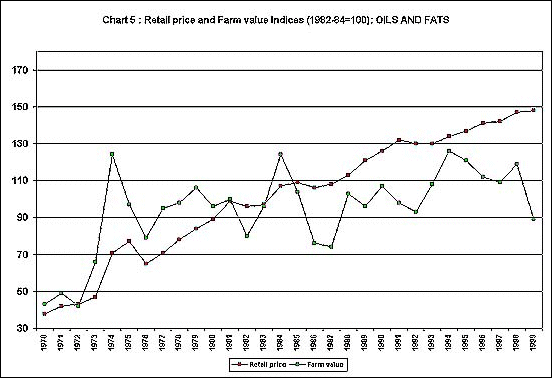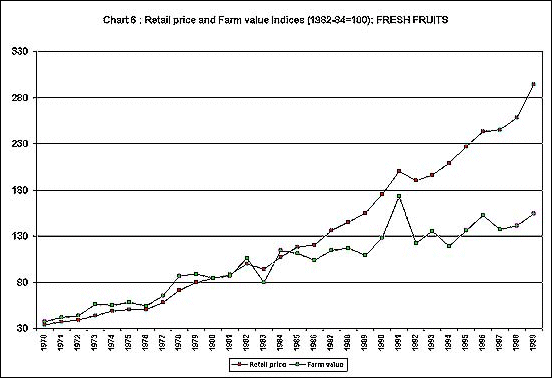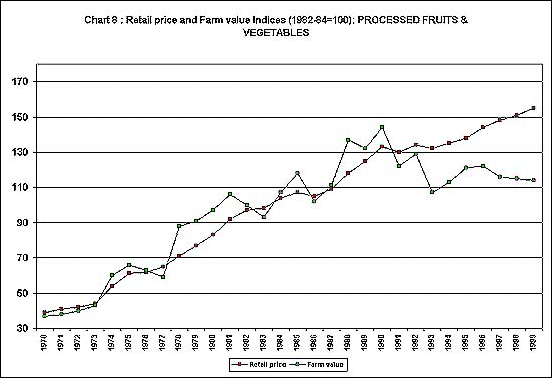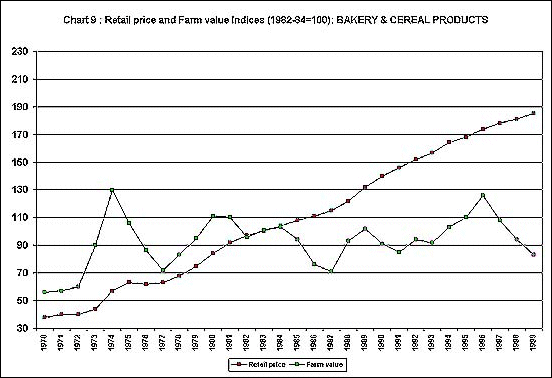Themes > Features
17.04.2001
The Forced
It is no secret that
the United States, like most other developed economies, provides large
subsidies to its farming sector. It is also no secret that these subsidies
have not really been reduced after WTO was formed, and that despite
the GATT Agreement on Agriculture, farm subsidies in most of the OECD
countries are now back to pre-GATT levels.
What has been a relatively well-kept secret, however, is that these
subsidies have not really benefited farmers so much as they have contributed
to greater profits of the giant corporations that now control the distribution
and marketing of food products. This is marked in the US, which is particularly
striking because the US economy is widely cited as one with relatively
low marketing margins among developed countries.
At first glance, this appears hard to accept. After all, expenditure
on food in the US has been rising at a significant rate over the past
decade. And this has been combined with subsidies of various types which
have circumvented the GATT restrictions by using "Green Box",
restructuring and other provisions to provide subsidies which are now
as high as a proportion of the final value of output as they were in
the late 1980s.
The paradox can be explained in terms of the widening margins going
to marketing and distribution. The share of this in total value added
in the total food expenditure in the US has gone up dramatically sine
1980. This can be gleaned from Chart 1, which shows index numbers of
total food spending and farm receipts in the US, in terms of current
US dollars. As evident from the Chart, while total food spending has
ballooned, farm receipts have barely risen even in current price terms,
and the gap between them has increased most strikingly over the 1990s.

Obviously,
this is even more marked in terms of real values. In constant price
terms (that, calculated at 1982-1984 real US dollars) between 1970 and
1999, consumer food spending increased by 30 per cent, the marketing
bill rose by 54 per cent, and farm value actually declined by 21 per
cent. Much of this process was due to specific trends of the 1990s.
US consumers spent $618.4 billion on food in 1999 (excluding imports
and seafood), up 37 percent from the amount spent in 1990.
Between 1990 and 1999,
marketing costs rose 45 percent and accounted for most of the 37-percent
rise in domestic consumer food spending. In comparison, the farm value
of food purchases climbed only 13 percent between 1990 and 1999.
The higher
marketing costs not only raised consumer food expenditures, but also
increased the share of expenditures attributable to marketing. In 1999,
marketing costs accounted for 80 percent of total consumer food spending,
with farm value accounting for the remaining 20 percent. In comparison,
the marketing bill accounted for 76 percent of 1990 consumer expenditures
and farm value 24 percent.
While these figures are cited in current dollars, the story is similar
when they are adjusted for inflation. Between 1990 and 1999, marketing
costs rose 14 percent, while consumer food expenditures climbed 8 percent
in real dollar terms. Meanwhile, the farm value of food purchases dropped
11 percent.
Most mainstream analysts
have attributed this to shifting tastes and patterns of demand, reflecting
not only Engels Curve type changes but also changing work participation
rates of women. Thus, consumers bought a larger volume of food, value-added
processing and packaging of at-home foods increased, spending at restaurants
and fast food outlets grew, and prices for marketing inputs rose. A
changing workforce — comprising more working women and more two-income
households — meant that busy consumers of the 1990's demanded quick,
easy-to-prepare convenience foods. The strong economy of the late 1990's
raised incomes and allowed more consumers to pay for highly processed
convenience foods.
It is typically suggested that all of these factors were the dominant
contributors to the jump in food spending during the 1990's. Certainly,
they played a role, but there were other important changes in production
organisation which were probably even more significant. This is discussed
in more detail below, after a look at the detailed trends.
A look at the more disaggregated data shows that this broad tendency
of divergence between farm values and retail prices is evident in all
the major food subsectors. Charts 2-9 show the index numbers of constant
price trends of retail and values received by farmers for a wide range
of food subsectors. These charts are very instructive.
Consider the case of meat products, shown in Chart 2. Until the mid-1980s,
not only did the two indices move together, but farm value changes tended
to be more than retail prices. From 1986 onwards, that pattern has been
reversed. And from 1990, farm values have been declining quite sharply
even as retail prices have continued to rise. By the late 1990s, the
gap between the two was enormous.



Very similar trends are evident for poultry (Chart 3) and for dairy products (Chart 4), the only difference being that in the 1990s in these two subsectors farm values do not decline as in meat products, but remain broadly stagnant. Similarly for fresh fruits (Chart 6) and fresh vegetables (Chart 7). However, the point about the latter two is that there is less scope for further and further processing in these, and therefore the discrepancy between retail price and farm value may be more reflective of increases in marketing margins rather than actual changes in the degree of processing.



This is especially evident in the case of fats and oilseeds (Chart 5), where the extent of processing is largely unchanged over the period. Farm values for oilseeds show a volatile, fluctuating pattern similar to that on foodgrains and a number of other agricultural products. Furthermore, these are cyclical patterns around a stagnant secular trend. However, retail prices of fats and oilseeds show a rising trend, and by the 1990s, this trend shows rates of increase which are not only smoother but substantially more than the change in farm values. And the same holds for bakery and cereal products.


This is not something
that can be explained only or even dominantly by changes in levels of
processing, changed consumer tastes and preferences, etc. Clearly, something
else has been going on. And that other process, which has operated to
increase the share of value accruing to the distribution, is the increasing
corporatisation of food production and concentration of agro-industries,
especially in the US but also in the rest of the world.
The process of concentration of industry is one that has affected virtually
all productive sectors in the world economy. It is just as evident in
the food processing and marketing sector, which was already a more concentrated
sector at the beginning of the decade of the 1990s. As a consequence,
a handful of large companies now handle, control or are involved in
some way in almost all aspects of production and distribution of food.
In the US, where the process of corporatisation of agriculture is not
only well advanced but has accelerated over the 1990s.
Consider the companies that now control certain important food sectors
in the US economy :
-
in grain trade and processing: Cargill (which swallowed Continental, the second-largest grain trader), Archer Daniels Midland (ADM), ConAgra.
-
in beef packing and distribution : IBP, ConAgra, Cargill (as owner of Excel).
-
in cattle feed : Cargill, Cactus Feeders, ConAgra.
-
in pork processing : Smithfield, IBP, ConAgra, Cargill.
-
in hog raising : Smithfield (the largest pork processor has bought the largest and second-largest hog producers, Murphy Family Farms and Carroll's Foods), Cargill, Seaboard.
-
in biotech and seeds: Monsanto, Cargill, DuPont/Pioneer, Novartis, Aventis.
-
in supermarkets: Kroger, Albertson's, Safeway, AHOLD (Giant), Winn-Dixie, Wal-Mart.
The repetition of a few names confirms the point that,
as in some other interconnected industries, a few diversified firms
are positioned on many sides of the market at once. Increasingly, the
process of mergers and acquisitions are connected through a complicated
system of "strategic alliances" and cross-ownership.
Thus, Smithfield, the world's largest hog producer
and pork processor, recently bought a 6.3 percent stake in its rival
company IBP, the second-largest pork processor. ADM already owned a
12.2 percent share of IBP. This kind of cross-ownership is likely to
continue, as IBP itself is now to be acquired in a friendly takeover
by the Wall Street brokerage firm Donaldson, Lufkin & Jenrette (which
was recently bought by Credit Suisse First Boston). Cargill and Monsanto
have a complex and elaborate web of joint ventures that runs from fertiliser
and seeds to grain and raising cattle, hogs, turkeys and chickens, then
on to the butcheries and packing plants.
According to one recent estimate (William Grieder
in the Nation, November 20, 2000) this means a frightening degree of
concentration sector by sector. Four firms control 82 percent of the
beef packing industry, 75 percent of delivery of hogs and sheep, and
half of chickens. Major supermarket chains are now concentrated regionally
within the US, though not nationally. Four firms hold 74 percent of
market control in ninety-four large cities; experts anticipate a new
merger wave that could swiftly increase that percentage while doubling
the four firms' overall national concentration up to 60 percent.
It
is not just that the "consumers" so beloved of mainstream
economic theory are adversely affected by these levels of concentration
and effective monopoly. It is also precisely this kind of market leverage
that has given the large companies a pricing advantage over farmers
and ranchers. And it is this which explains the rising spread between
the prices received by farmers
and livestock breeders, and the retail prices, that is so evident from
the charts.
Thus, companies regularly exploit this market leverage,
and the degree of control created by vertical integration of breathtaking
dimensions, to depress market prices for independent, relatively small
producers. In some cases the control is direct. Thus, owning feedlots,
or (an increasingly common practice) signing output contracts with
individual farmers for poultry, hogs, cattle and even grain and soyabean,
gives the processing companies access to their own captive supplies.
Even when there is no such
overt control, the ability of marketing giants to hold their own private
stores of livestock or grain or oilseeds means that they no longer have
to rely on the traditional auction based purchases in the open market
to provide most of their supply. This has affected the auction markets
as well, rendering the prices for farmers lower and more volatile.
The recent crashes in world trading prices have speeded
up these processes. Two consequences of this are now clear. One, is
that it drove many American farmers into rushing to accept whatever
new technology offered cost cutting or output increasing effects. Thus,
farmers sought more capital-intensive cultivation, and Monsanto and
other companies were also easily able to persuade farmers to adopt their
genetically modified seeds for corn and soyabean in particular. The
other impact of the price collapse is that it has driven many farmers
many more farmers into accepting the status of contract producer growing
crops of livestock under fixed-price contracts with the corporations.
This model is eerily reminiscent of the process of
forced commercialisation in Indian agriculture over the nineteenth century,
when small farmers were incorporated into a global economy through a
process of debt engagement or through contracts of purchase where the
ultimate buyer (say, for example, the opium or indigo planter) also
offered inputs such as seeds and other working capital and bound the
formerly independent producer into a subservient relationship.
Of course, in the US this process is occurring in
an already capitalist agriculture which is highly sophisticated in terms
of techniques and production organisation. For that reason, it also
bears similarity with the pattern of organisation in contemporary major
industrial sectors in developed economies. Here a large corporation
- say Nike or Benetton - organises a complex but disparate and shifting
network of affiliated producers, subcontractors and distributors, who
all adhere to its brand standards.
This entire process has been dramatically
described as follows :
"Farmers
can see themselves being reduced from their mythological status as independent
producers to a subservient and vulnerable role as sharecroppers or franchisees.
The control of food production, both livestock and crops, is being consolidated
not by the government but by a handful of giant corporations. While
farmers and ranchers suffered three years of severely depressed prices
at the close of the 1990s, the corporations enjoyed soaring profits
from the same line of goods. Growers are surrounded now on both sides
- facing concentrated market power not only from the companies that
buy their crops and animals but also from the firms that sell them essential
inputs like seeds and fertiliser. In the final act of unfettered capitalism,
the free market itself is destroyed." (William Grieder, "The
last farm crisis", The Nation, November 20, 2000)
American
farmers are effectively being incorporated
into a peculiar collectivisation of agriculture, where those in control
are large multinational companies operating all the way along the value
chain. And it is this model of growing corporatisation of agricultural
and agro-processed commodity production which is being upheld as an
example for other countries, and which is effectively being pushed on
to a whole range of developing countries such as India. In fact, the
current Indian government has already shown that it is very much in
favour of such a trend, and has provided further incentives to strengthen
such a process in the recent Annual Central Government Budget as well
as in the latest Exim Policy.
The effects of such a policy on American farmers,
who are already quite well off, and financially and politically strong,
are now apparent. But this process is likely to be much more devastating
in terms of its impact on Indian cultivators, a majority of whom are
already operating at the margin of subsistence.
© MACROSCAN 2001